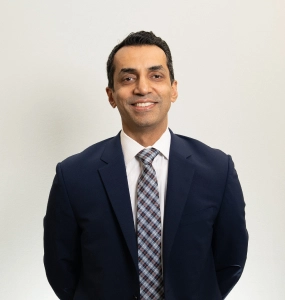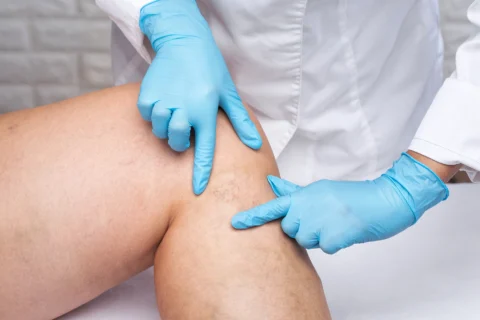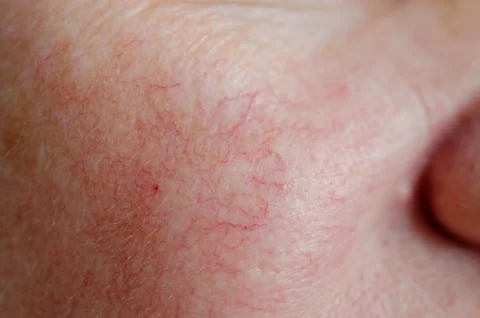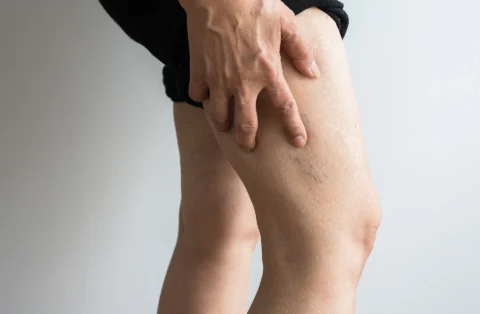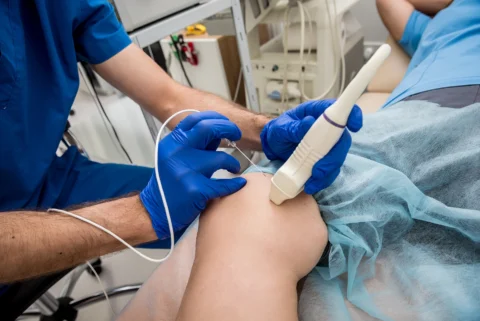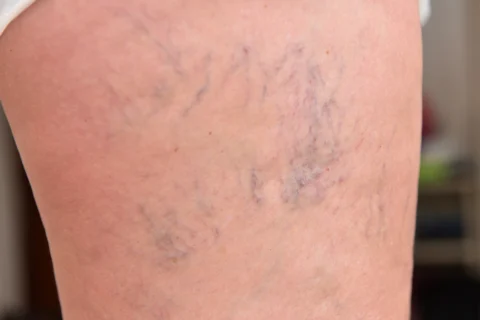Banish those tiny tangled veins for good with the latest minimally invasive procedures
Small spider veins, the tiny purple, red, and blue squiggly lines that spider web across your legs, can be unsightly and frustrating to deal with. While mostly harmless, their appearance can impact self-confidence. Luckily, several effective and minimally invasive treatments are available to banish spider veins for good.
Read on to learn about the leading procedures and how to choose the right option for your needs.
What are Spider Veins?

Spider veins, also called telangiectasias, are tiny dilated blood vessels that appear close to the surface of the skin. They got their creepy crawly name from their spindly shape.
While similar to varicose veins, spider veins are smaller, measuring about 1-3 millimeters. They also differ in that they don’t bulge under the skin like varicose veins.
Spider veins frequently occur on the legs and feet but can also appear on the face and other areas of the body. Some contributing factors include:
- Hormonal changes
- Weight gain
- Pregnancy
- Standing for long periods
- Blood clots
- Trauma to the skin
Though usually not painful, spider veins can cause uncomfortable symptoms like aching, burning, swelling, and night cramps. Their appearance also leads many to seek treatment.
Ready to bid farewell to spider veins? Schedule a consultation with our specialists today!
Now let’s explore your options to banish those unsightly spots!
1. Sclerotherapy
Sclerotherapy is the most popular and well-established treatment for eliminating spider veins. This minimally invasive procedure involves injecting a solution, called a sclerosant, directly into the affected veins.
The sclerosant irritates the lining of the vein, causing it to swell shut. Over time, the vein turns into scar tissue that the body absorbs, fading the vein. The sclerosant commonly used is sodium tetradecyl sulfate or polidocanol.
The procedure takes only about 30 minutes for small areas. Larger areas may require multiple sessions. You can usually return to normal activity immediately afterward. Most patients need 2-5 treatments spaced 4-6 weeks apart for best results.
| Pros | Cons |
| Minimally invasive | Multiple treatments usually needed |
| Fast, with little downtime | Does not work well on larger varicose veins |
| Effective on small veins | Bruising, redness, and soreness may occur after treatment |
| Minimal risk or side effects | |
| Does not require anesthesia |
Sclerotherapy remains the first-line treatment for small spider veins on the legs and face. When performed correctly by an experienced vein specialist, it can remove small spider veins with excellent cosmetic results and high patient satisfaction.
2. Laser Treatments
Laser therapy provides another effective and non-invasive treatment option for zapping away spider veins. Several types of lasers are used:
Endovenous Laser Ablation (EVLA)
EVLA is one of the most common laser procedures to eliminate spider veins. It uses a tiny laser fiber guided by ultrasound imaging to deliver pulses of laser energy into the affected vein.
The heat from the laser causes the vein walls to collapse and seal shut. Blood flow is naturally rerouted to healthier veins. Over time, your body reabsorbs the sealed vein.
| Pros | Cons |
| Minimally invasive | Requires specialized training and equipment |
| Fast recovery time | Not as effective for very tiny veins |
| High success rates | Risk of bruising, numbness, and scarring |
| Can treat deeper veins |
Intense Pulsed Light (IPL)
For small facial spider veins, IPL treatments can help reduce their appearance. The technology uses broad spectrum light at different wavelengths to selectively target blood vessels just below the skin’s surface.
The light converts to heat energy, which damages the vein, prompting it to fade. Several treatments spaced a month apart are usually required. IPL is not as effective on spider veins on the legs.
Pulsed Dye Lasers
Pulsed dye lasers are considered the gold standard for removing facial telangiectasias. The concentrated dye laser light specifically targets the color in blood vessels, heating up the veins causes them to fade.
Like IPL, multiple treatments are typically needed for best results on small facial veins. Some mild bruising may occur.
3. Radiofrequency Ablation
This technology uses either monopolar or bipolar radiofrequency energy to painlessly heat and close off damaged spider veins.
A small catheter is inserted into the target vein. The radiofrequency waves agitate the veins walls, causing scar tissue to form that seals the vein shut. Blood flow is naturally redirected into healthier veins.
| Pros | Cons |
| Minimally invasive procedure | Multiple treatments usually required |
| Fast recovery with no downtime | Risk of temporary numbness, tingling, swelling |
| High success rates | Not as effective for tiniest spider veins |
| Does not require hospitalization |
Radiofrequency ablation, like laser and sclerotherapy, represents an effective solution for eliminating stubborn spider veins on the legs. Remember that multiple sessions are usually needed for full results.
4. VenaSeal
VenaSeal represents an innovative alternative to sclerotherapy for spider veins. This minimally invasive treatment uses a specially formulated medical adhesive, rather than sclerosant, to close abnormal veins.
The adhesive is injected directly into the target vein using ultrasound guidance. It acts almost like glue to seal the vein shut and allow it to close down. Over time, your body naturally absorbs the sealed vein.
| Pros | Cons |
| Minimally invasive procedure | Relatively new treatment, long-term results unknown |
| Virtually painless with mild discomfort | Risk of bruising, swelling, tenderness after procedure |
| Quick 20-30 minute treatment time | Not covered by all insurance plans |
| Safe with minimal side effects | |
| No need for multiple sessions |
The main advantage of VenaSeal is that it usually requires only a single session, unlike most other spider vein procedures needing multiple treatments. Being a newer therapy, long-term results are still being evaluated.
5. Compression Therapy
Compression therapy is often used together with other treatments like sclerotherapy or EVLA to enhance results. Compression stockings worn after procedures can:
- Minimize bruising, inflammation and pain
- Improve venous circulation and drainage
- Speed up the body’s absorption of treated veins
- Prevent recurrence of new spider veins
Patients are usually advised to wear 20-30 mmHg compression stockings continuously for 1-2 weeks after treatment. Then stockings can be worn for just the daytime for another week or two.
Some physicians may recommend compression for up to 6 months post-treatment to maximize improvements. Compliance with compression garments often makes the difference between good and great results.
Maximize your spider vein treatment results with The Vein Center Doctor’s minimally invasive treatments – contact us to learn more!
Natural Remedies for Small Spider Veins

For mild spider veins, some patients opt to try home remedies and natural treatments first before pursuing medical procedures. Some options include:
- Apple cider vinegar – Its mild acids may improve circulation. Apply topically daily.
- Witch hazel – An astringent that may reduce veins’ appearance when applied regularly.
- Essential oils – Massage with antioxidant oils like grapeseed oil to stimulate blood flow.
- Herbal supplements – Garlic, turmeric, and vitamin C supplements to strengthen veins.
- Exercise – Any activity that gets blood flowing can minimize spider veins.
However, while these natural methods are safe, inexpensive, and easy to try, results tend to be minor and temporary. Medical procedures remain far more effective for significant, longer-lasting removal of spider veins.
Topical Creams for Mild Support
Over-the-counter creams containing certain ingredients can provide mild improvements for very mild spider veins. They help strengthen the vein walls and improve microcirculation.
Two of the most effective ingredients to look for are:
Vitamin K – Helps repair broken capillaries when applied topically. Brands like Steri-Vein provide easy applications.
Retinoids – Increase cell turnover to gradually reduce veins’ visibility. RoC Retinol Correxion Cream is a popular drugstore option.
Used diligently, these products may gradually reduce the appearance of very tiny new spider veins. However, they do not work well on larger varicose veins or severe cases. Professional procedures remain the most effective treatment approach.
Treatment Comparison Chart
Here is a quick overview comparing the leading medical spider vein treatments:
| Treatment | Procedures Needed | Downtime | Best For | Side Effects |
| Sclerotherapy | 2-5 spaced 4-6 weeks | Minimal | Small leg and facial veins | Bruising, redness |
| Laser Therapy | 2-6 spaced 4 weeks | 1-2 days | Small veins, good for face | Bruising, swelling |
| Radiofrequency | 2-4 spaced 1 month | Minimal | Small veins on legs | Temporary numbness |
| VenaSeal | Often just 1 | 1-3 days | Small leg veins | Bruising, tenderness |
| Compression | After treatments | N/A | Enhances other treatments | Potential discomfort |
Which Treatment Is Right for You?
With several excellent options available, choosing the right spider vein removal treatment depends on:
- Size of veins: Sclerotherapy and VenaSeal work better on smaller veins of less than 3mm. Lasers and radiofrequency handle larger veins more effectively.
- Location: Lasers are particularly effective for delicate facial veins. Sclerotherapy is better suited for legs.
- Number of veins: Treatments like VenaSeal requiring only one session may be preferred if you have extensive veins.
- Your medical history: Any conditions like blood clotting disorders may preclude certain procedures.
- Costs and insurance coverage: If paying out of pocket, less expensive options like sclerotherapy may be preferable.
- Downtime: Those unable to take much time off work may opt for quicker treatments like VenaSeal.
An experienced vein specialist can best evaluate your individual case and recommend the optimal treatments. Most spider veins require 2-4 sessions spaced 3-6 weeks apart for gradual complete clearance.
Find your perfect spider vein treatment match with expert guidance from The Vein Center Doctor – contact us now!
Banish Spider Veins for Good with Vein Center Doctor

Tired of unsightly spider veins on your legs? The Vein Center Doctor offers innovative treatments to banish spider veins for good. Our minimally invasive procedures precisely target affected veins with little discomfort and no downtime. Even delicate facial telangiectasia can be dramatically improved.
While small spider veins may return over time, most patients find the long-term improvements highly worthwhile. Don’t let embarrassing spider veins impact your confidence any longer. The Vein Center Doctor’s skilled specialists have extensive training with advanced vein removal techniques.
We provide:
- Thorough evaluation and accurate diagnosis
- Customized treatment plans for optimal results
- Efficient procedures with minimal invasiveness
- Prompt appointments and quick recovery
Rediscover confident, gorgeous legs again! Contact the Vein Center Doctor today to learn more about your treatment options from trusted experts. Call 1-862-500-4747 now to schedule your spider vein consultation.
